Formation of the Granodiorite-Hosting Magushan Cu–Mo Polymetallic Deposit in Southern Anhui, Eastern China: Evidences from Geochronology and Geochemistry
Abstract
1. Introduction
2. Geological Setting
2.1. Regional Geology
2.2. Geology of Deposit
3. Methods
3.1. Whole-Rock Major and Trace Elements
3.2. Zircon U-Pb Isotopes Analyses
3.3. Zircon Lu–Hf Isotopes
3.4. Sr–Nd–Pb Isotopes
4. Results
4.1. Whole-Rock Geochemistry
4.2. Zircon U–Pb Geochronology and Trace Elements
4.3. Zircon Lu–Hf Isotopes
4.4. Sr–Nd–Pb Isotopes
5. Discussion
5.1. Ages of the Magushan Granodiorites
5.2. Petrogenesis of the Magushan Granodiorites
5.2.1. Genetic Type: An I-type Affinity
5.2.2. Petrogenesis
5.2.3. Physical-Chemical Conditions of Magma
5.3. Tectonic Setting of Magmatism and Cu–Mo Mineralization
6. Conclusions
Supplementary Materials
Author Contributions
Funding
Acknowledgments
Conflicts of Interest
References
- Chang, Y.; Liu, X.; Wu, Y.-C. The Copper–Iron Belt of the Lower and Middle Reaches of the Changjiang River; Beijing Geol. Pub. House: Beijing, China, 1991; pp. 1–56. [Google Scholar]
- Pan, Y.; Dong, P. The Lower Changjiang (Yangzi/Yangtze River) metallogenic belt, east central China: Intrusion and wall rock-hosted Cu–Fe–Au, Mo, Zn, Pb, Ag deposits. Ore Geol. Rev. 1999, 15, 177–242. [Google Scholar] [CrossRef]
- Mao, J.; Zhang, J.; Pirajno, F.; Ishiyama, D.; Su, H.; Guo, C.; Chen, Y. Porphyry Cu–Au–Mo–epithermal Ag–Pb–Zn–distal hydrothermal Au deposits in the Dexing area, Jiangxi province, East China—A linked ore system. Ore Geol. Rev. 2011, 43, 203–216. [Google Scholar] [CrossRef]
- Yang, X.-Y.; Lee, I. Review of the stable isotope geochemistry of Mesozoic igneous rocks and Cu–Au deposits along the Middle–Lower Yangtze metallogenic belt, China. Int. Geol. Rev. 2011, 53, 741–757. [Google Scholar] [CrossRef]
- Zhou, T.; Wang, S.; Fan, Y.; Yuan, F.; Zhang, D.; White, N.C. A review of the intracontinental porphyry deposits in the Middle–Lower Yangtze River Valley metallogenic belt, Eastern China. Ore Geol. Rev. 2015, 65, 433–456. [Google Scholar] [CrossRef]
- Pan, X.; Hou, Z.; Li, Y.; Chen, G.; Zhao, M.; Zhang, T.; Zhang, C.; Wei, J.; Kang, C. Dating the giant Zhuxi W–Cu deposit (Taqian–Fuchun Ore Belt) in South China using molybdenite Re–Os and muscovite Ar–Ar system. Ore Geol. Rev. 2017, 86, 719–733. [Google Scholar] [CrossRef]
- Mao, Z.; Cheng, Y.; Liu, J.; Yuan, S.; Wu, S.; Xiang, X.; Luo, X. Geology and molybdenite Re–Os age of the Dahutang granite-related veinlets-disseminated tungsten ore field in the Jiangxin Province, China. Ore Geol. Rev. 2013, 53, 422–433. [Google Scholar] [CrossRef]
- Mao, J.; Xiong, B.; Liu, J.; Pirajno, F.; Cheng, Y.; Ye, H.; Song, S.; Dai, P. Molybdenite Re/Os dating, zircon U–Pb age and geochemistry of granitoids in the Yangchuling porphyry W–Mo deposit (Jiangnan tungsten ore belt), China: Implications for petrogenesis, mineralization and geodynamic setting. Lithos 2017, 286, 35–52. [Google Scholar] [CrossRef]
- Zhou, X.; Yu, X.; Wang, D.; Zhang, D.; Li, C.; Fu, J.; Dong, H. Characteristics and geochronology of the W, Mo-bearing granodiorite porphyry in Dongyuan, southern Anhui. Geoscience 2011, 25, 201–210. (In Chinese) [Google Scholar]
- Su, Q.; Mao, J.; Wu, S.; Zhang, Z.; Xu, S. Geochronology and geochemistry of the granitoids and ore-forming age in the Xiaoyao tungsten polymetallic skarn deposit in the Jiangnan Massif tungsten belt, China: Implications for their petrogenesis, geodynamic setting, and mineralization. Lithos 2018, 296, 365–381. [Google Scholar] [CrossRef]
- Zhu, Z.-Y.; Jiang, S.-Y.; Hu, J.; Gu, L.-X.; Li, J. Geochronology, geochemistry, and mineralization of the granodiorite porphyry hosting the Matou Cu–Mo (±W) deposit, Lower Yangtze River metallogenic belt, eastern China. J. Asian Earth Sci. 2014, 79, 623–640. [Google Scholar] [CrossRef]
- Song, G.; Qin, K.; Li, G.; Liu, T.; Li, J.; Li, X.; Chang, Z. Geochronologic and isotope geochemical constraints on magmatism and associated W–Mo mineralization of the Jitoushan W–Mo deposit, Middle–Lower Yangtze Valley. Int. Geol. Rev. 2012, 54, 1532–1547. [Google Scholar] [CrossRef]
- Xie, J.; Tang, D.; Xia, D.; Wang, Y.; Li, Q.; Yang, X.; Sun, W. Geochronological and geochemical constraints on the formation of Chizhou Cu–Mo polymetallic deposits, Middle and Lower Yangtze metallogenic belt, eastern China. Ore Geol. Rev. 2019, 109, 322–347. [Google Scholar] [CrossRef]
- Xue, H.; Ma, F.; Song, X. Geochronology and geochemistry of the Neoproterozoic granitoid association from eastern segment of the Jiangnan Orogen, China: Constraints on the timing and process of amalgamation between the Yangtze and Cathaysia blocks. Acta Petrol. Sin. 2010, 26, 3215–3244. (In Chinese) [Google Scholar]
- Qin, Y.; Wang, D.; Li, Y.; Wang, K.; Wu, L.; Mei, Y. Rock-forming and ore-forming ages of the Baizhangyan tungsten-molybdenum ore deposit in Qingyang, Anhui Province and their geological significance. Earth Sci. Front. 2010, 17, 170–177. (In Chinese) [Google Scholar]
- Zhang, Z.-Y.; Du, Y.-S.; Teng, C.-Y.; Zhang, J.; Pang, Z.-S. Petrogenesis, geochronology, and tectonic significance of granitoids in the Tongshan intrusion, Anhui Province, Middle–Lower Yangtze River Valley, eastern China. J. Asian Earth Sci. 2014, 79, 792–809. [Google Scholar] [CrossRef]
- Wu, F.-Y.; Ji, W.-Q.; Sun, D.-H.; Yang, Y.-H.; Li, X.-H. Zircon U–Pb geochronology and Hf isotopic compositions of the Mesozoic granites in southern Anhui Province, China. Lithos 2012, 150, 6–25. [Google Scholar] [CrossRef]
- Zhou, J.; Jiang, Y.-H.; Xing, G.; Zeng, Y.; Ge, W. Geochronology and petrogenesis of Cretaceous A-type granites from the NE Jiangnan Orogen, SE China. Int. Geol. Rev. 2013, 55, 1359–1383. [Google Scholar] [CrossRef]
- Wang, X.-L.; Zhou, J.-C.; Griffin, W.; Zhao, G.; Yu, J.-H.; Qiu, J.-S.; Zhang, Y.-J.; Xing, G.-F. Geochemical zonation across a Neoproterozoic orogenic belt: Isotopic evidence from granitoids and metasedimentary rocks of the Jiangnan orogen, China. Precambrian Res. 2014, 242, 154–171. [Google Scholar] [CrossRef]
- Gu, H.; Yang, X.; Deng, J.; Duan, L.; Liu, L. Geochemical and zircon U–Pb geochronological study of the Yangshan A-type granite: Insights into the geological evolution in south Anhui, eastern Jiangnan Orogen. Lithos 2017, 284, 156–170. [Google Scholar] [CrossRef]
- Yan, J.; Hou, T.; Wang, A.; Wang, D.; Zhang, D.; Weng, W.; Liu, J.; Liu, X.; Li, Q. Petrogenetic contrastive studies on the Mesozoic early stage ore-bearing and late stage ore-barren granites from the southern Anhui Province. Sci. China Earth Sci. 2017, 60, 1920–1941. [Google Scholar] [CrossRef]
- Zhang, Y.-S.; Yan, J.; Li, Q.-Z.; Liu, X.-Q.; Gao, R.; Chen, F. Pulses of Late Mesozoic magmatism: Zircon ages and Hf–O isotopic composition of the Qingyang-Jiuhuashan granitic complex, southern Anhui province, eastern China. J. Asian Earth Sci. 2018, 167, 181–196. [Google Scholar] [CrossRef]
- Song, G.; Qin, K.; Li, G.; Evans, N.J.; Li, X. Mesozoic magmatism and metallogeny in the Chizhou area, Middle–Lower Yangtze Valley, SE China: Constrained by petrochemistry, geochemistry and geochronology. J. Asian Earth Sci. 2014, 91, 137–153. [Google Scholar] [CrossRef]
- Li, J.-W.; Zhao, X.-F.; Zhou, M.-F.; Vasconcelos, P.; Ma, C.-Q.; Deng, X.-D.; de Souza, Z.S.; Zhao, Y.-X.; Wu, G. Origin of the Tongshankou porphyry–skarn Cu–Mo deposit, eastern Yangtze craton, Eastern China: Geochronological, geochemical, and Sr–Nd–Hf isotopic constraints. Miner. Depos. 2008, 43, 315–336. [Google Scholar] [CrossRef]
- Cao, Y.; Zheng, Z.; Du, Y.; Gao, F.; Qin, X.; Yang, H.; Lu, Y.; Du, Y. Ore geology and fluid inclusions of the Hucunnan deposit, Tongling, Eastern China: Implications for the separation of copper and molybdenum in skarn deposits. Ore Geol. Rev. 2017, 81, 925–939. [Google Scholar] [CrossRef]
- Wang, X.-L.; Zhou, J.-C.; Wan, Y.-S.; Kitajima, K.; Wang, D.; Bonamici, C.; Qiu, J.-S.; Sun, T. Magmatic evolution and crustal recycling for Neoproterozoic strongly peraluminous granitoids from southern China: Hf and O isotopes in zircon. Earth Planet. Sci. Lett. 2013, 366, 71–82. [Google Scholar] [CrossRef]
- Zhang, S.-B.; Zheng, Y.-F. Formation and evolution of Precambrian continental lithosphere in South China. Gondwana Res. 2013, 23, 1241–1260. [Google Scholar] [CrossRef]
- Zhai, Y.; Xiong, Y.; Yao, S.; Lin, X. Metallogeny of copper and iron deposits in the Eastern Yangtse Craton, east-central China. Ore Geol. Rev. 1996, 11, 229–248. [Google Scholar] [CrossRef]
- Jiang, S.-Y.; Zhao, K.-D.; Jiang, Y.-H.; Dai, B.-Z. Characteristics and genesis of Mesozoic A-type granites and associated mineral deposits in the southern Hunan and northern Guangxi provinces along the Shi-Hang belt, South China. Geol. J. China Univ. 2008, 14, 496–509. (In Chinese) [Google Scholar]
- Liu, Y.; Liu, H.; Li, X. Simultaneous and precise determination of 40 trace elements in rock samples using ICP-MS. Geochimica 1996, 25, 552–558. [Google Scholar]
- Liu, Y.; Hu, Z.; Gao, S.; Günther, D.; Xu, J.; Gao, C.; Chen, H. In situ analysis of major and trace elements of anhydrous minerals by LA-ICP-MS without applying an internal standard. Chem. Geol. 2008, 257, 34–43. [Google Scholar] [CrossRef]
- Ludwig, K. Users Manual for ISOPLOT/EX, Version 3: A Geochronological Toolkit for Microsoft Excel; Berkeley Geochronology Center Special Publication: Berkeley, CA, USA, 2003; pp. 1–39. [Google Scholar]
- Yuan, H.-L.; Gao, S.; Dai, M.-N.; Zong, C.-L.; Günther, D.; Fontaine, G.H.; Liu, X.-M.; Diwu, C. Simultaneous determinations of U–Pb age, Hf isotopes and trace element compositions of zircon by excimer laser-ablation quadrupole and multiple-collector ICP-MS. Chem. Geol. 2008, 247, 100–118. [Google Scholar] [CrossRef]
- Bouvier, A.; Vervoort, J.D.; Patchett, P.J. The Lu–Hf and Sm–Nd isotopic composition of CHUR: constraints from unequilibrated chondrites and implications for the bulk composition of terrestrial planets. Earth Planet. Sci. Lett. 2008, 273, 48–57. [Google Scholar] [CrossRef]
- Griffin, W.; Pearson, N.; Belousova, E.; Jackson, S.; Van Achterbergh, E.; O’Reilly, S.Y.; Shee, S. The Hf isotope composition of cratonic mantle: LAM-MC-ICPMS analysis of zircon megacrysts in kimberlites. Geochim. Cosmochim. Acta 2000, 64, 133–147. [Google Scholar] [CrossRef]
- Rudnick, R.L.; Gao, S. Composition of the continental crust. Treatise Geochem. 2003, 3, 1–64. [Google Scholar]
- Chen, F.; Satir, M.; Ji, J.; Zhong, D. Nd–Sr–Pb isotopes of Tengchong Cenozoic volcanic rocks from western Yunnan, China: Evidence for an enriched-mantle source. J. Asian Earth Sci. 2002, 21, 39–45. [Google Scholar] [CrossRef]
- Middlemost, E.A. Naming materials in the magma/igneous rock system. Earth-Sci. Rev. 1994, 37, 215–224. [Google Scholar] [CrossRef]
- Irvine, T.; Baragar, W. A guide to the chemical classification of the common volcanic rocks. Can. J. Earth Sci. 1971, 8, 523–548. [Google Scholar] [CrossRef]
- Peccerillo, A.; Taylor, S. Geochemistry of Eocene calc-alkaline volcanic rocks from the Kastamonu area, northern Turkey. Contrib. Mineral. Petrol. 1976, 58, 63–81. [Google Scholar] [CrossRef]
- Sun, S.-S.; McDonough, W.-S. Chemical and isotopic systematics of oceanic basalts: implications for mantle composition and processes. Geol. Soc., Lond., Spec. Publ. 1989, 42, 313–345. [Google Scholar] [CrossRef]
- Hoskin, P.W.; Ireland, T.R. Rare earth element chemistry of zircon and its use as a provenance indicator. Geology 2000, 28, 627–630. [Google Scholar] [CrossRef]
- Belousova, E.; Griffin, W.L.; O’Reilly, S.Y.; Fisher, N. Igneous zircon: trace element composition as an indicator of source rock type. Contrib. Mineral. Petrol. 2002, 143, 602–622. [Google Scholar] [CrossRef]
- Zhang, C.-C.; Sun, W.-D.; Wang, J.-T.; Zhang, L.-P.; Sun, S.-J.; Wu, K. Oxygen fugacity and porphyry mineralization: A zircon perspective of Dexing porphyry Cu deposit, China. Geochim. Cosmochim. Acta 2017, 206, 343–363. [Google Scholar] [CrossRef]
- Ferry, J.; Watson, E. New thermodynamic models and revised calibrations for the Ti-in-zircon and Zr-in-rutile thermometers. Contrib. Mineral. Petrol. 2007, 154, 429–437. [Google Scholar] [CrossRef]
- Guo, J.-L.; Gao, S.; Wu, Y.-B.; Li, M.; Chen, K.; Hu, Z.-C.; Liang, Z.-W.; Liu, Y.-S.; Zhou, L.; Zong, K.-Q. 3.45 Ga granitic gneisses from the Yangtze Craton, South China: Implications for Early Archean crustal growth. Precambrian Res. 2014, 242, 82–95. [Google Scholar] [CrossRef]
- Zhang, Q.; Jin, W.; Wang, Y.; Li, C.; Wang, Y.; Jia, X. A model of delamination of continental lower crust. Acta Petrol. Sin. 2006, 22, 265–276. (In Chinese) [Google Scholar]
- Hu, J.; Liu, X.; Chen, L.; Qu, W.; Li, H.; Geng, J. A ∼2.5 Ga magmatic event at the northern margin of the Yangtze craton: Evidence from U–Pb dating and Hf isotope analysis of zircons from the Douling Complex in the South Qinling orogen. Chin. Sci. Bull. 2013, 58, 3564–3579. [Google Scholar] [CrossRef]
- Hofmann, A. Sampling mantle heterogeneity through oceanic basalts: Isotopes and trace elements. Treatise Geochem. 2003, 2, 61–101. [Google Scholar]
- Huang, F.; Li, S.; Dong, F.; He, Y.; Chen, F. High-Mg adakitic rocks in the Dabie orogen, central China: Implications for foundering mechanism of lower continental crust. Chem. Geol. 2008, 255, 1–13. [Google Scholar] [CrossRef]
- Chen, D.; Zhi, X.; Li, B.; Wang, Y.; Yang, J. The Nd, Sr and Pb isotopic characteristics of lherzolite xenoliths from Panshishan, Jiangsu Province. Geochimica 1994, 3, 245–253. (In Chinese) [Google Scholar]
- Yan, J.; Liu, J.; Li, Q.; Xing, G.; Liu, X.; Xie, J.; Chu, X.; Chen, Z. In situ zircon Hf–O isotopic analyses of late Mesozoic magmatic rocks in the Lower Yangtze River Belt, central eastern China: Implications for petrogenesis and geodynamic evolution. Lithos 2015, 227, 57–76. [Google Scholar] [CrossRef]
- Chen, J.-F.; Yan, J.; Xie, Z.; Xu, X.; Xing, F. Nd and Sr isotopic compositions of igneous rocks from the Lower Yangtze region in eastern China: constraints on sources. Phys. Chem. Earth, Part A: Solid Earth Geod. 2001, 26, 719–731. [Google Scholar] [CrossRef]
- Gao, S.; Ling, W.; Qiu, Y.; Lian, Z.; Hartmann, G.; Simon, K. Contrasting geochemical and Sm–Nd isotopic compositions of Archean metasediments from the Kongling high-grade terrain of the Yangtze craton: evidence for cratonic evolution and redistribution of REE during crustal anatexis. Geochim. Cosmochim. Acta 1999, 63, 2071–2088. [Google Scholar] [CrossRef]
- Jahn, B.; Wu, F.; Lo, C.-H.; Tsai, C.-H. Crust–mantle interaction induced by deep subduction of the continental crust: geochemical and Sr–Nd isotopic evidence from post-collisional mafic–ultramafic intrusions of the northern Dabie complex, central China. Chem. Geol. 1999, 157, 119–146. [Google Scholar] [CrossRef]
- Wang, Q.; Wyman, D.A.; Xu, J.; Jian, P.; Zhao, Z.; Li, C.; Xu, W.; Ma, J.; He, B. Early Cretaceous adakitic granites in the Northern Dabie Complex, central China: Implications for partial melting and delamination of thickened lower crust. Geochim. Cosmochim. Acta 2007, 71, 2609–2636. [Google Scholar] [CrossRef]
- Xie, J.; Yang, X.; Sun, W.; Du, J. Early Cretaceous dioritic rocks in the Tongling region, eastern China: Implications for the tectonic settings. Lithos 2012, 150, 49–61. [Google Scholar] [CrossRef]
- Xie, J.; Wang, Y.; Li, Q.; Yan, J.; Sun, W. Petrogenesis and metallogenic implications of Late Mesozoic intrusive rocks in the Tongling region, eastern China: A case study and perspective review. Int. Geol. Rev. 2018, 60, 1361–1380. [Google Scholar] [CrossRef]
- Wang, Q.; Wyman, D.A.; Xu, J.-F.; Zhao, Z.-H.; Jian, P.; Xiong, X.-L.; Bao, Z.-W.; Li, C.-F.; Bai, Z.-H. Petrogenesis of Cretaceous adakitic and shoshonitic igneous rocks in the Luzong area, Anhui Province (eastern China): Implications for geodynamics and Cu–Au mineralization. Lithos 2006, 89, 424–446. [Google Scholar] [CrossRef]
- Yan, J.; Chen, J.-F.; Xu, X.-S. Geochemistry of Cretaceous mafic rocks from the Lower Yangtze region, eastern China: Characteristics and evolution of the lithospheric mantle. J. Asian Earth Sci. 2008, 33, 177–193. [Google Scholar] [CrossRef]
- Mao, J.; Wang, Y.; Lehmann, B.; Yu, J.; Du, A.; Mei, Y.; Li, Y.; Zang, W.; Stein, H.J.; Zhou, T. Molybdenite Re–Os and albite 40Ar/39Ar dating of Cu–Au–Mo and magnetite porphyry systems in the Yangtze River valley and metallogenic implications. Ore Geol. Rev. 2006, 29, 307–324. [Google Scholar] [CrossRef]
- Xue, H.; Wang, Y.; Ma, F.; Wang, C.; Wan, D.; Zuo, Y. Zircon U–Pb SHRIMP ages of the Taiping (calc-alkaline)-Huangshan (alkaline) composite intrusion: Constraints on Mesozoic lithospheric thinning of the southeastern Yangtze Craton, China. Sci. China Ser. D: Earth Sci. 2009, 52, 1756. [Google Scholar] [CrossRef]
- Su, Y.; Zheng, J.; Griffin, W.L.; Zhao, J.; Suzanne, Y.; Tang, H.; Ping, X.; Xiong, Q. Petrogenesis and geochronology of Cretaceous adakitic, I- and A-type granitoids in the NE Yangtze block: Constraints on the eastern subsurface boundary between the North and South China blocks. Lithos 2013, 175, 333–350. [Google Scholar] [CrossRef]
- Chen, H.; Zhang, J.; Jia, P.; Li, D.; Zhang, Z.; Wang, Y. Re–Os isotopic dating of sulfides from the Tongshan copper deposit, Anhui Province and its geological implications. Acta Petrol. Sin. 2011, 27, 1779–1784. (In Chinese) [Google Scholar]
- Whalen, J.B.; Currie, K.L.; Chappell, B.W. A-type granites: geochemical characteristics, discrimination and petrogenesis. Contrib. Mineral. Petrol. 1987, 95, 407–419. [Google Scholar] [CrossRef]
- Collins, W.; Beams, S.; White, A.; Chappell, B. Nature and origin of A-type granites with particular reference to southeastern Australia. Contrib. Mineral. Petrol. 1982, 80, 189–200. [Google Scholar] [CrossRef]
- Chappell, B.W.; White, A.J. Two contrasting granite types: 25 years later. Aust. J. Earth Sci. 2001, 48, 489–499. [Google Scholar] [CrossRef]
- Barbarin, B. A review of the relationships between granitoid types, their origins and their geodynamic environments. Lithos 1999, 46, 605–626. [Google Scholar] [CrossRef]
- Li, X.-H.; Li, Z.-X.; Li, W.-X.; Liu, Y.; Yuan, C.; Wei, G.; Qi, C. U–Pb zircon, geochemical and Sr–Nd–Hf isotopic constraints on age and origin of Jurassic I- and A-type granites from central Guangdong, SE China: A major igneous event in response to foundering of a subducted flat-slab? Lithos 2007, 96, 186–204. [Google Scholar] [CrossRef]
- Chappell, B.; Bryant, C.; Wyborn, D.; White, A.; Williams, I. High- and low-temperature I-type granites. Resour. Geol. 1998, 48, 225–235. [Google Scholar] [CrossRef]
- Defant, M.J.; Drummond, M.S. Derivation of some modern arc magmas by melting of young subducted lithosphere. Nature 1990, 347, 662–665. [Google Scholar] [CrossRef]
- Xie, J.; Xia, D.; Fang, D.; Yan, J.; Yang, X.; Sun, W.; Li, Q. Geochemistry of Late Mesozioc granodiorites in southern Anhui Province: Constraints for rock- and ore-forming. Acta Petrol. Sin. 2016, 32, 439–455. (In Chinese) [Google Scholar]
- Li, C.; Jiang, Y.; Xing, G.; Guo, K.; Li, C.; Yu, M.; Zhao, P.; Wang, Z. Two periods of skarn mineralization in the B aizhangyan W–Mo deposit, southern Anhui province, Southeast China: Evidence from zircon U–Pb and molybdenite Re–Os and sulfur isotope data. Resour. Geol. 2015, 65, 193–209. [Google Scholar] [CrossRef]
- Sun, W.; Zhang, H.; Ling, M.-X.; Ding, X.; Chung, S.-L.; Zhou, J.; Yang, X.-Y.; Fan, W. The genetic association of adakites and Cu–Au ore deposits. Int. Geol. Rev. 2011, 53, 691–703. [Google Scholar] [CrossRef]
- Sun, W.; Ding, X.; Ling, M.-X.; Zartman, R.E.; Yang, X.-Y. Subduction and ore deposits. Int. Geol. Rev. 2015, 57, 3–6. [Google Scholar] [CrossRef]
- Cocherie, A. Systematic use of trace element distribution patterns in log-log diagrams for plutonic suites. Geochim. Cosmochim. Acta 1986, 50, 2517–2522. [Google Scholar] [CrossRef]
- Yang, W.; Zhang, H.-F. Zircon geochronology and Hf isotopic composition of Mesozoic magmatic rocks from Chizhou, the Lower Yangtze Region: constraints on their relationship with Cu–Au mineralization. Lithos 2012, 150, 37–48. [Google Scholar] [CrossRef]
- Deng, J.; Yang, X.; Li, S.; Gu, H.; Mastoi, A.S.; Sun, W. Partial melting of subducted paleo-Pacific plate during the early Cretaceous: Constraint from adakitic rocks in the Shaxi porphyry Cu–Au deposit, Lower Yangtze River Belt. Lithos 2016, 262, 651–667. [Google Scholar] [CrossRef]
- Hu, Z.; Yang, X.; Duan, L.; Sun, W. Geochronological and geochemical constraints on genesis of the adakitic rocks in Outang, South Tan–Lu Fault Belt (Northeastern Yangtze Block). Tectonophysics 2014, 626, 86–104. [Google Scholar] [CrossRef]
- Xie, J.; Wang, Y.; Li, Q.; Liu, J.; Yan, J.; Sun, W. Early Cretaceous adakitic rocks in the Anqing region, southeastern China: Constraints on petrogenesis and metallogenic significance. Int. Geol. Rev. 2018, 60, 1435–1452. [Google Scholar] [CrossRef]
- Zhong, J.; Chen, Y.; Pirajno, F. Geology, geochemistry and tectonic settings of the molybdenum deposits in South China: A review. Ore Geol. Rev. 2017, 81, 829–855. [Google Scholar] [CrossRef]
- Sun, W.; Huang, R.; Li, H.; Hu, Y.; Zhang, C.; Sun, S.; Zhang, L.; Ding, X.; Li, C.; Zartman, R. Porphyry deposits and oxidized magmas. Ore Geol. Rev. 2015, 65, 97–131. [Google Scholar] [CrossRef]
- Mungall, J.E. Roasting the mantle: Slab melting and the genesis of major Au and Au-rich Cu deposits. Geology 2002, 30, 915–918. [Google Scholar] [CrossRef]
- Watson, E.; Wark, D.; Thomas, J. Crystallization thermometers for zircon and rutile. Contrib. Mineral. Petrol. 2006, 151, 413. [Google Scholar] [CrossRef]
- Ballard, J.R.; Palin, M.J.; Campbell, I.H. Relative oxidation states of magmas inferred from Ce (IV)/Ce (III) in zircon: Application to porphyry copper deposits of northern Chile. Contrib. Mineral. Petrol. 2002, 144, 347–364. [Google Scholar] [CrossRef]
- Trail, D.; Watson, E.B.; Tailby, N.D. The oxidation state of Hadean magmas and implications for early Earth’s atmosphere. Nature 2011, 480, 79. [Google Scholar] [CrossRef]
- Trail, D.; Watson, E.B.; Tailby, N.D. Ce and Eu anomalies in zircon as proxies for the oxidation state of magmas. Geochim. Cosmochim. Acta 2012, 97, 70–87. [Google Scholar] [CrossRef]
- Li, Z.-X.; Li, X.-H. Formation of the 1300 km wide intracontinental orogen and postorogenic magmatic province in Mesozoic South China: A flat-slab subduction model. Geology 2007, 35, 179–182. [Google Scholar] [CrossRef]
- Li, X.-H.; Li, Z.-X.; Li, W.-X.; Wang, X.-C.; Gao, Y. Revisiting the “C-type adakites” of the Lower Yangtze River Belt, central eastern China: In-situ zircon Hf–O isotope and geochemical constraints. Chem. Geol. 2013, 345, 1–15. [Google Scholar] [CrossRef]
- Sun, W.; Ding, X.; Hu, Y.-H.; Li, X.-H. The golden transformation of the Cretaceous plate subduction in the west Pacific. Earth Planet. Sci. Lett. 2007, 262, 533–542. [Google Scholar] [CrossRef]
- Sun, W.-D.; Ling, M.-X.; Chung, S.-L.; Ding, X.; Yang, X.-Y.; Liang, H.-Y.; Fan, W.-M.; Goldfarb, R.; Yin, Q.-Z. Geochemical constraints on adakites of different origins and copper mineralization. J. Geol. 2012, 120, 105–120. [Google Scholar] [CrossRef]
- Xie, G.; Mao, J.; Li, R.; Bierlein, F.P. Geochemistry and Nd–Sr isotopic studies of Late Mesozoic granitoids in the southeastern Hubei province, Middle–Lower Yangtze River belt, Eastern China: Petrogenesis and tectonic setting. Lithos 2008, 104, 216–230. [Google Scholar] [CrossRef]
- Liu, L.; Geng, C.; Yanguang, L.; Xiaoyong, Y.M.S.; Qing, H. Mesozoic high- and low-SiO2 adakites and A-type granites in the Lower Yangtze River Belt, Eastern China: Implications for petrogenesis and metallogeny. Minerals 2018, 8, 328. [Google Scholar] [CrossRef]
- Zhou, X.; Sun, T.; Shen, W.; Shu, L.; Niu, Y. Petrogenesis of Mesozoic granitoids and volcanic rocks in South China: A response to tectonic evolution. Episodes 2006, 29, 26–33. [Google Scholar]
- Hu, Z.; Yang, X.; Lee, I. Geochemical study of Cretaceous magmatic rocks in Chuzhou region, low Yangtze River metallogenic belt: Implications for petrogenesis and Cu–Au mineralization. Int. Geol. Rev. 2018, 60, 1479–1506. [Google Scholar] [CrossRef]
- Hu, Q.; Gu, H.; Yang, X.; Ren, Y.; Gao, E.; Nie, Z. Geochemistry and geochronology of Late Jurassic and Early Cretaceous intrusions related to some Au (Sb) deposits in the southern Anhui: A case study and review. Acta Geochim. 2018, 37, 360–383. [Google Scholar] [CrossRef]
- Gu, H.; Yang, X.; Nie, Z.; Deng, J.; Duan, L.; Hu, Q.; Shakoor, M.; Gao, E.; Hafiz, A. Study of Late-Mesozoic magmatic rocks and their related copper-gold-polymetallic deposits in the Guichi ore-cluster district, Lower Yangtze River Metallogenic Belt, East China. Int. Geol. Rev. 2018, 60, 1404–1434. [Google Scholar] [CrossRef]
- Sun, W.; Liang, H.; Ling, M.; Zhan, M.; Ding, X.; Zhang, H.; Yang, X.; Li, Y.; Ireland, T.; Wei, Q. The link between reduced porphyry copper deposits and oxidized magmas. Geochim. Cosmochim. Acta 2013, 103, 263–275. [Google Scholar] [CrossRef]
- Sun, W.; Wang, J.; Zhang, L.; Zhang, C.; Li, H.; Ling, M.; Ding, X.; Li, C.; Liang, H. The formation of porphyry copper deposits. Acta Geochim. 2017, 36, 9–15. [Google Scholar] [CrossRef]
- Sun, W.; Arculus, R.J.; Kamenetsky, V.S.; Binns, R.A. Release of gold-bearing fluids in convergent margin magmas prompted by magnetite crystallization. Nature 2004, 431, 976–978. [Google Scholar] [CrossRef]
- Nadeau, O.; Williams-Jones, A.E.; Stix, J. Sulphide magma as a source of metals in arc-related magmatic hydrothermal ore fluids. Nat. Geosci. 2010, 3, 501–505. [Google Scholar] [CrossRef]
- Pearce, J.A.; Harris, N.B.; Tindle, A.G. Trace element discrimination diagrams for the tectonic interpretation of granitic rocks. J. Petrol. 1984, 25, 956–983. [Google Scholar] [CrossRef]
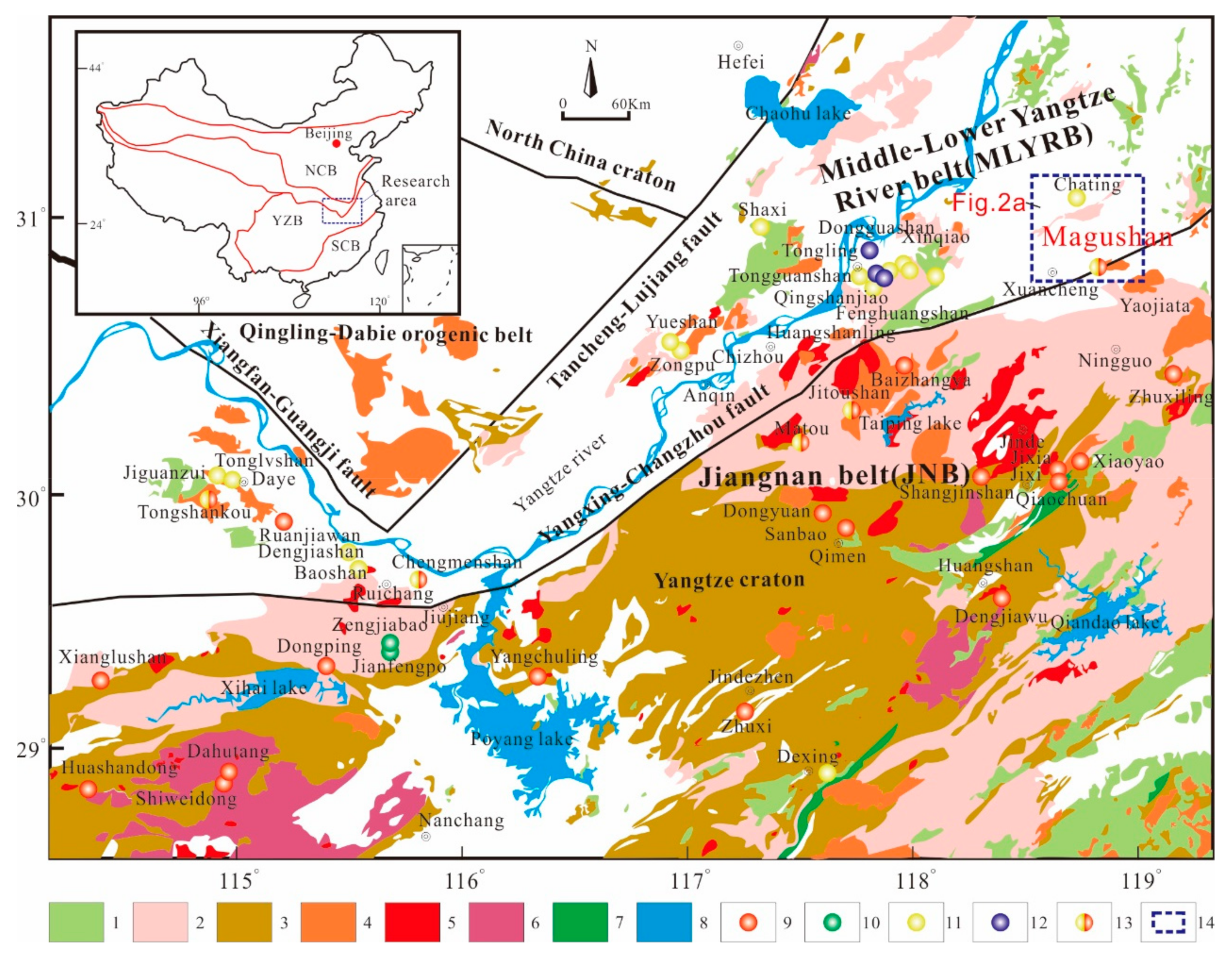
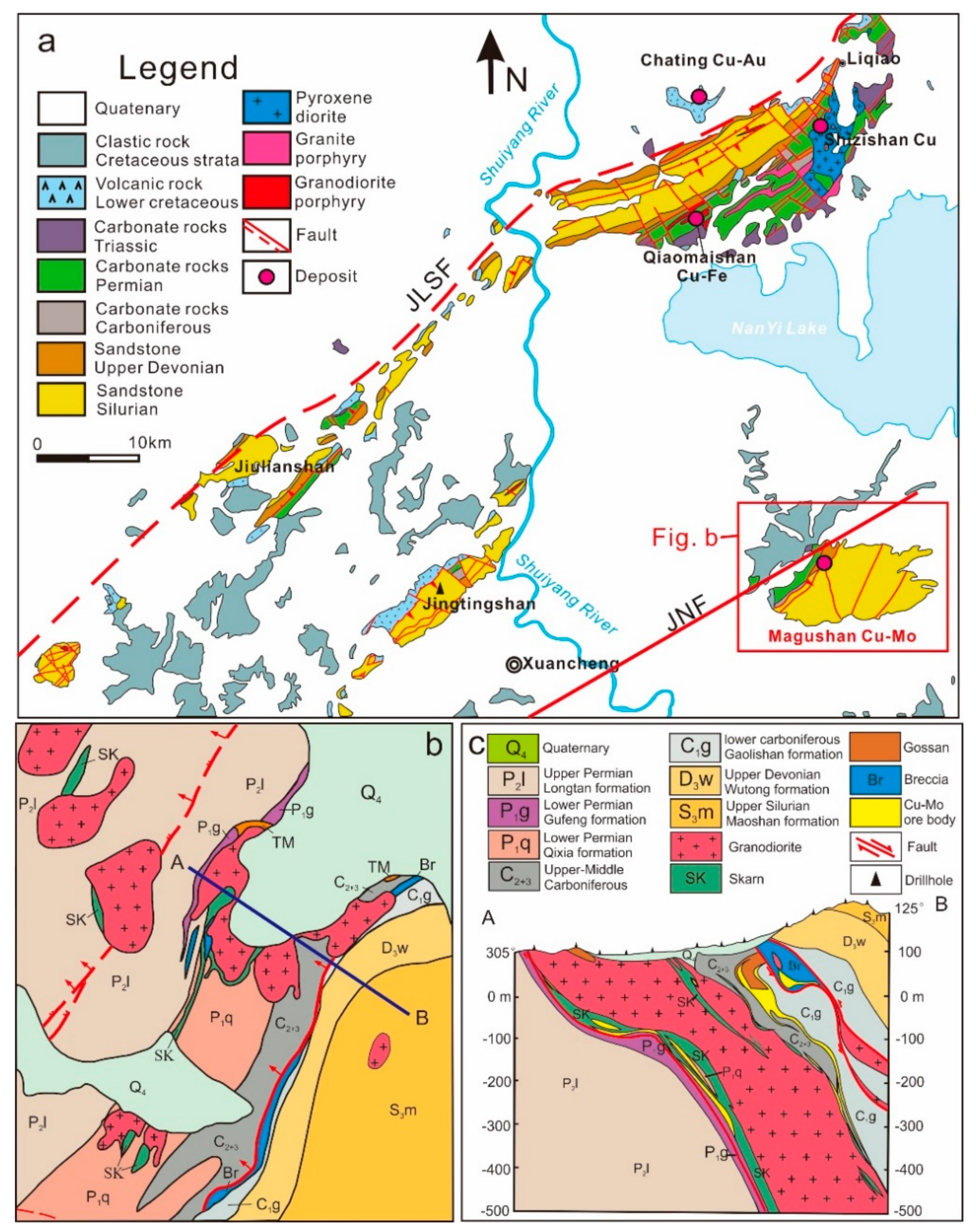


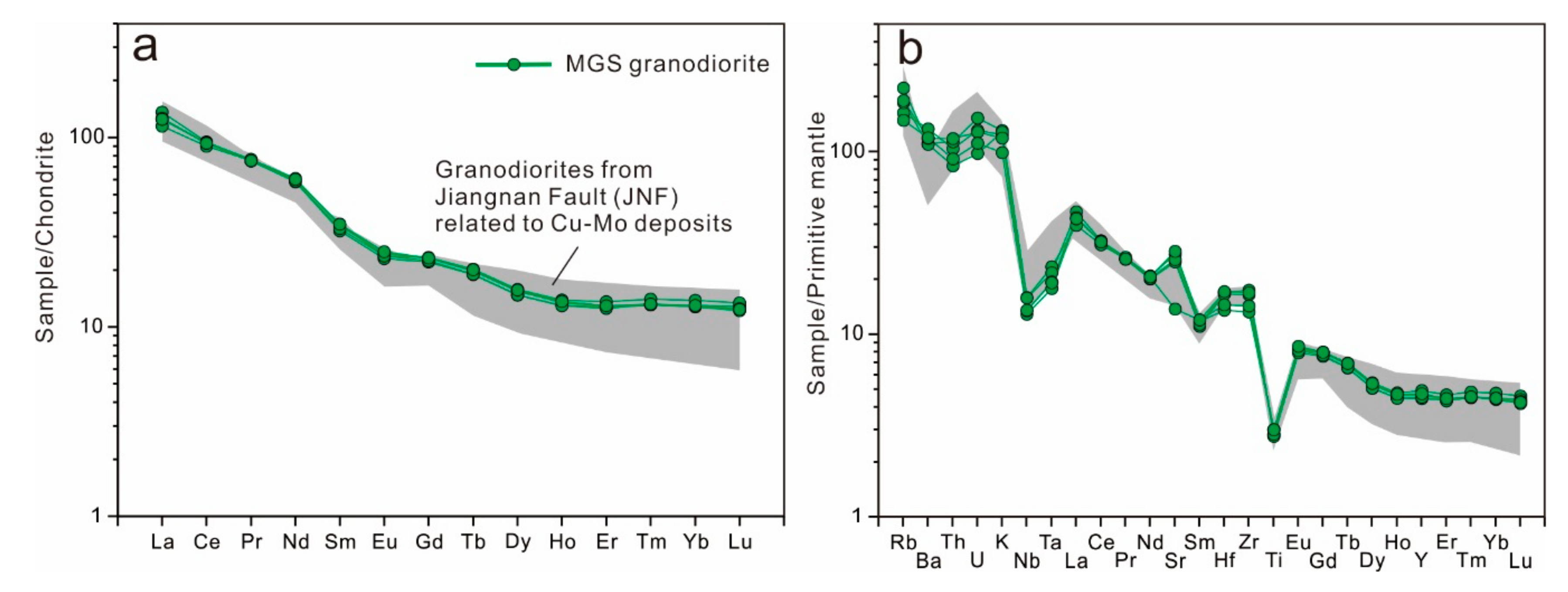
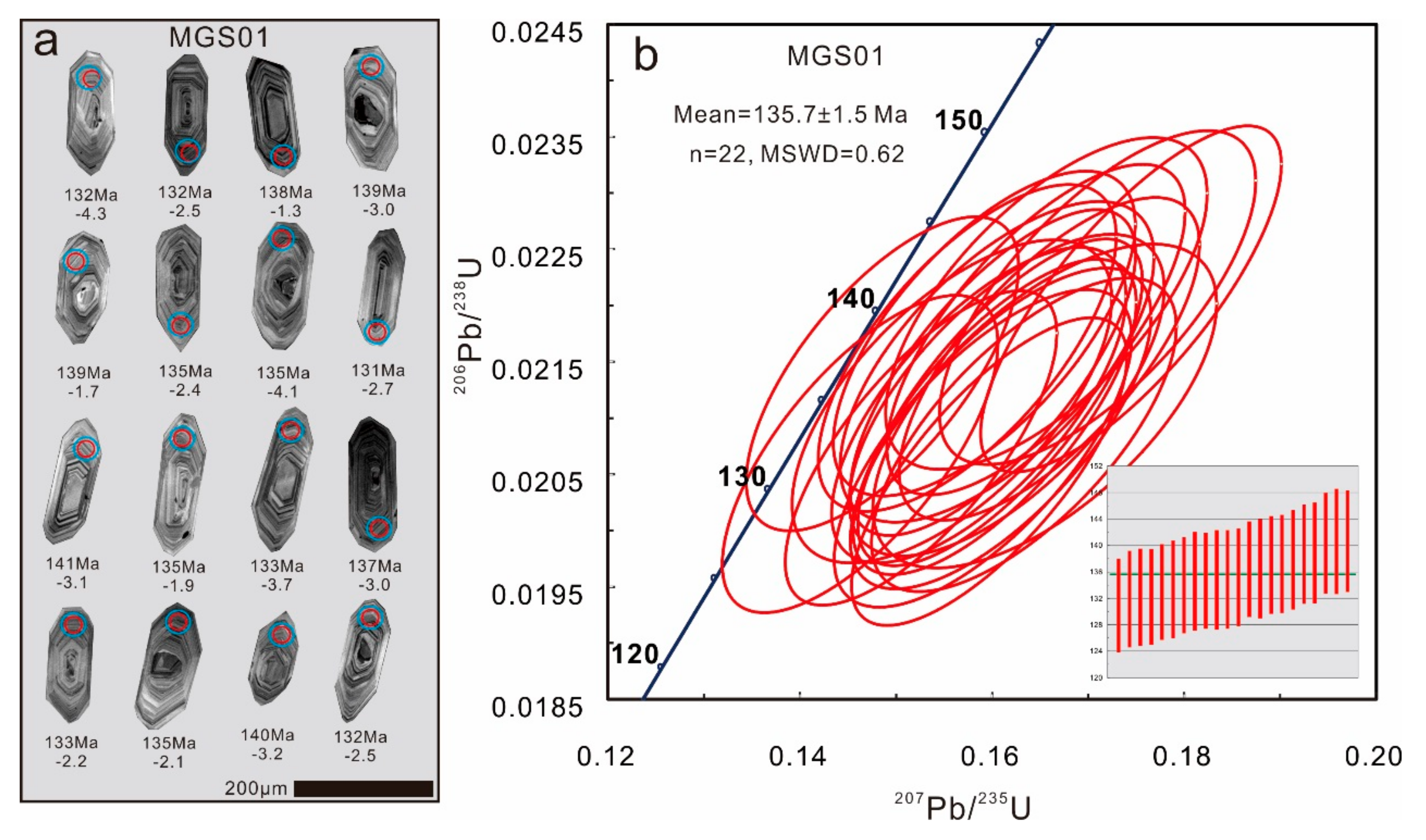
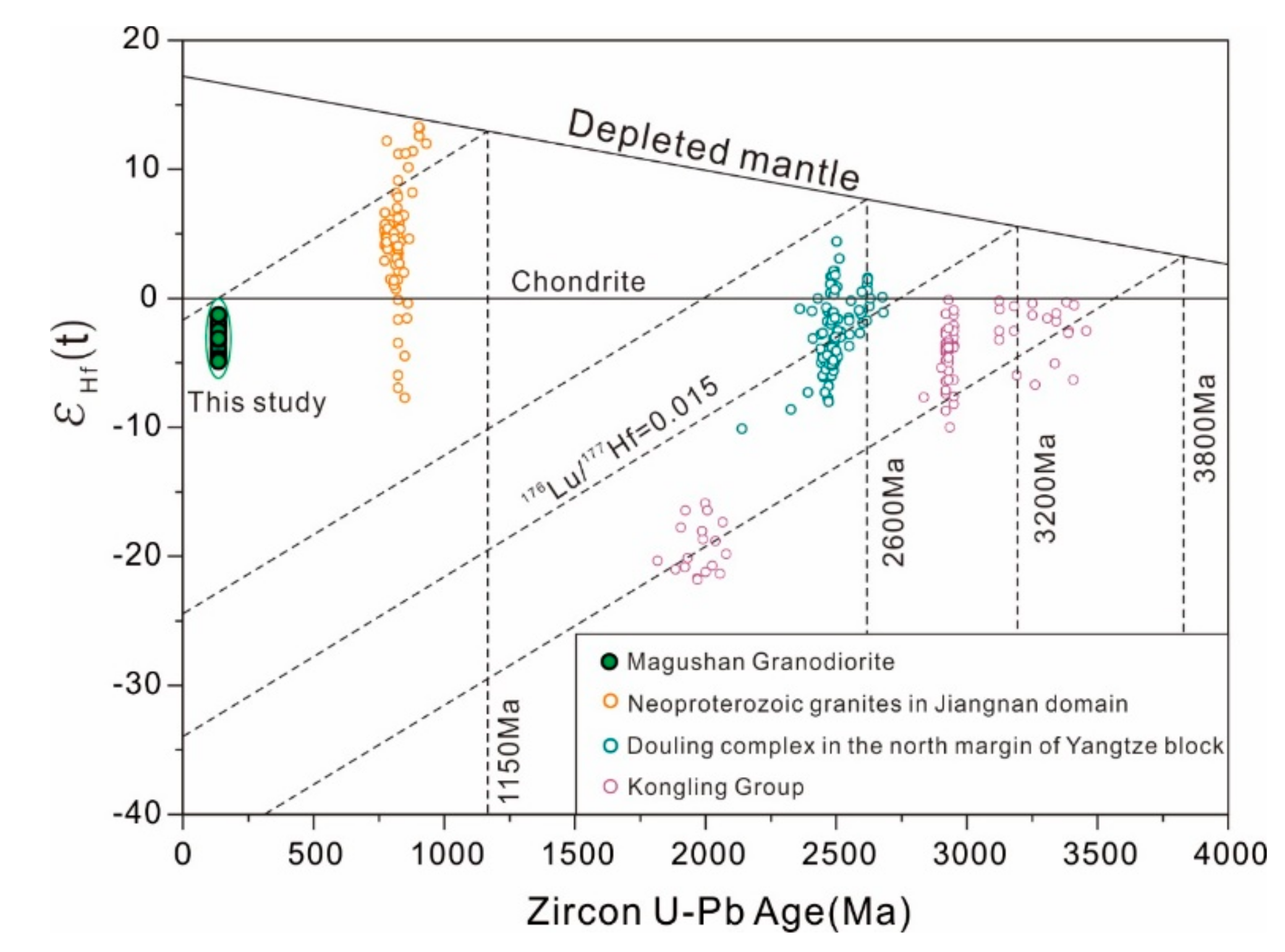
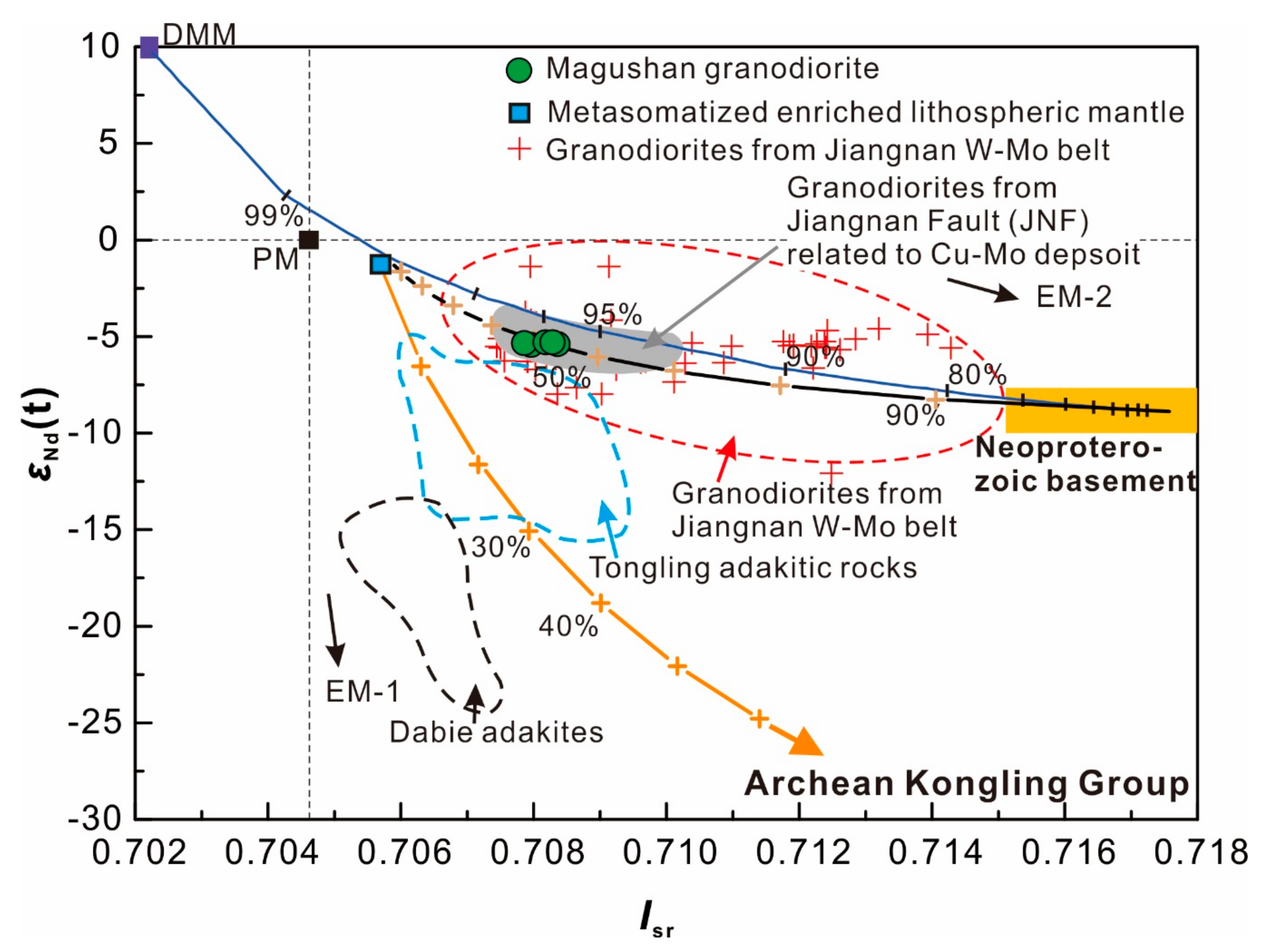
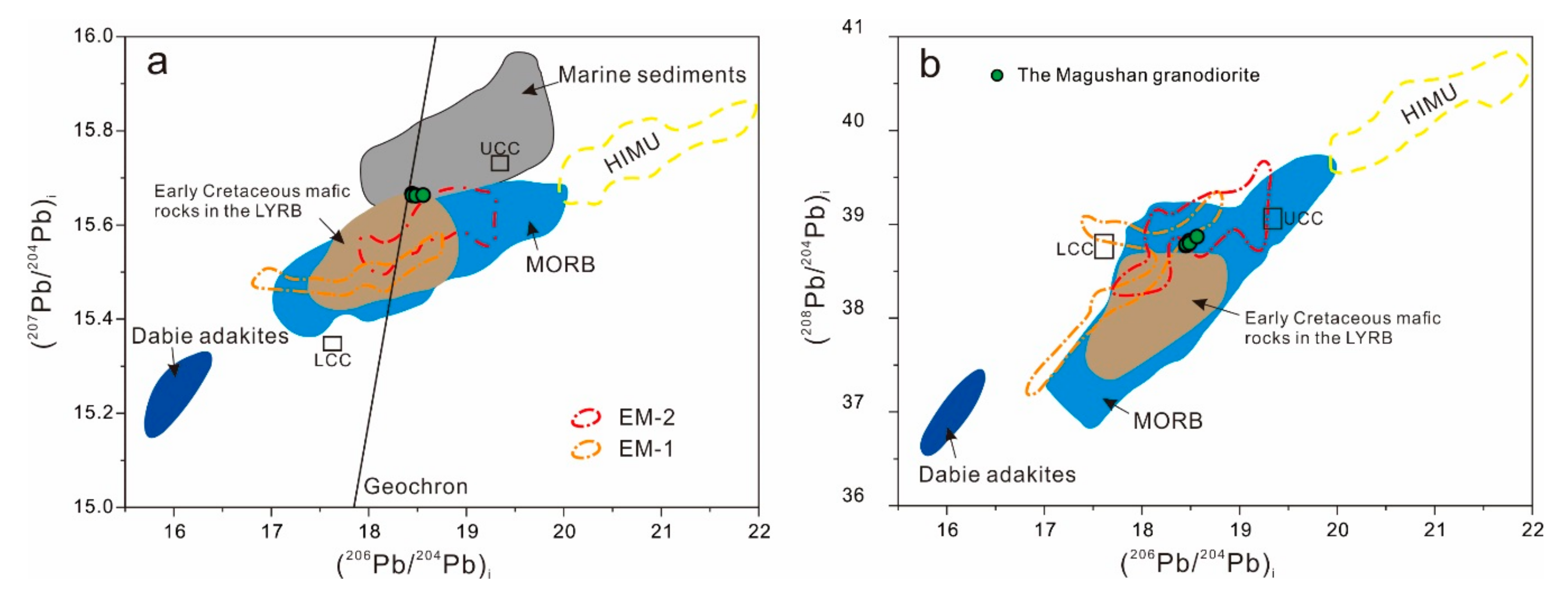

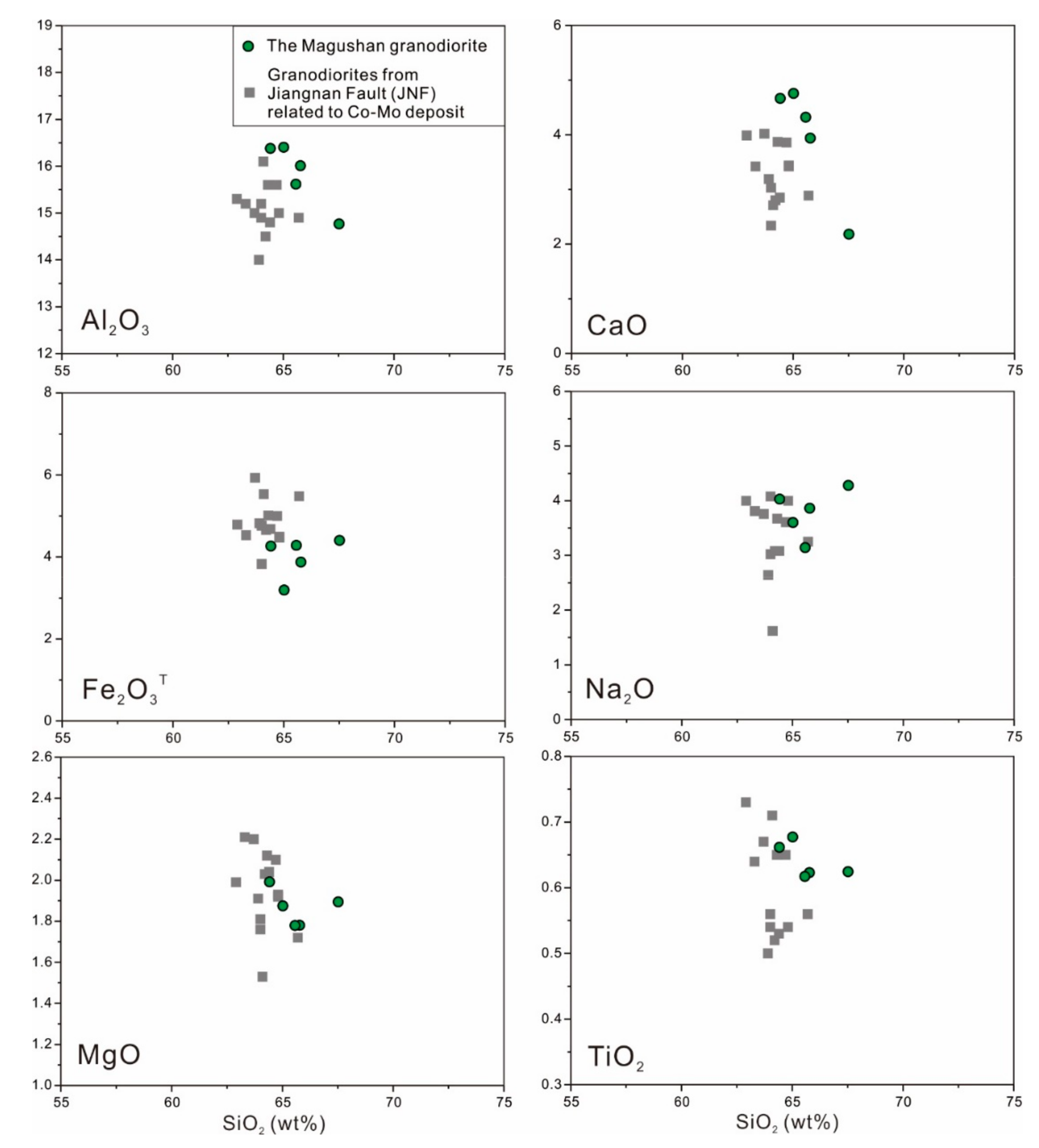
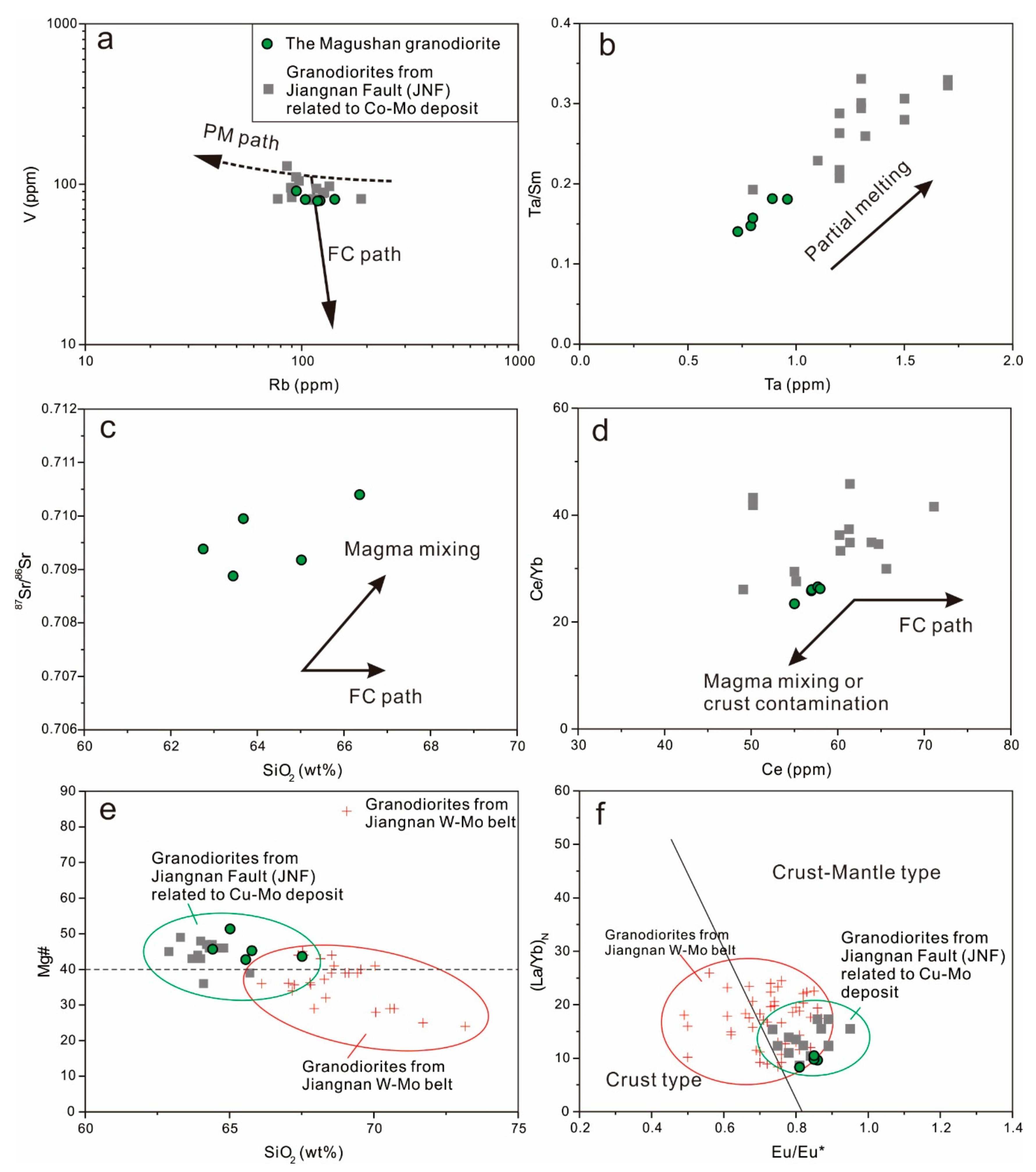

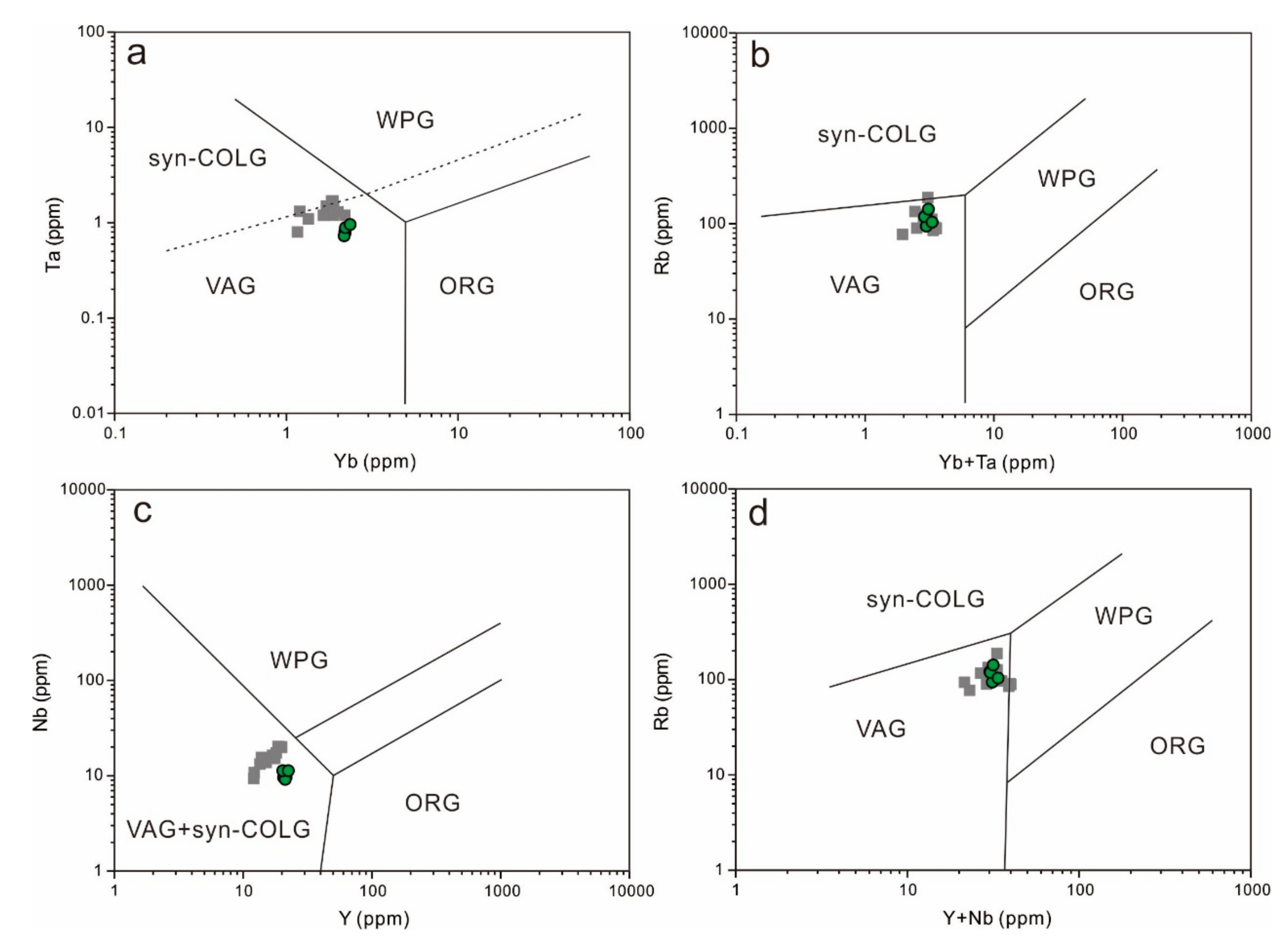
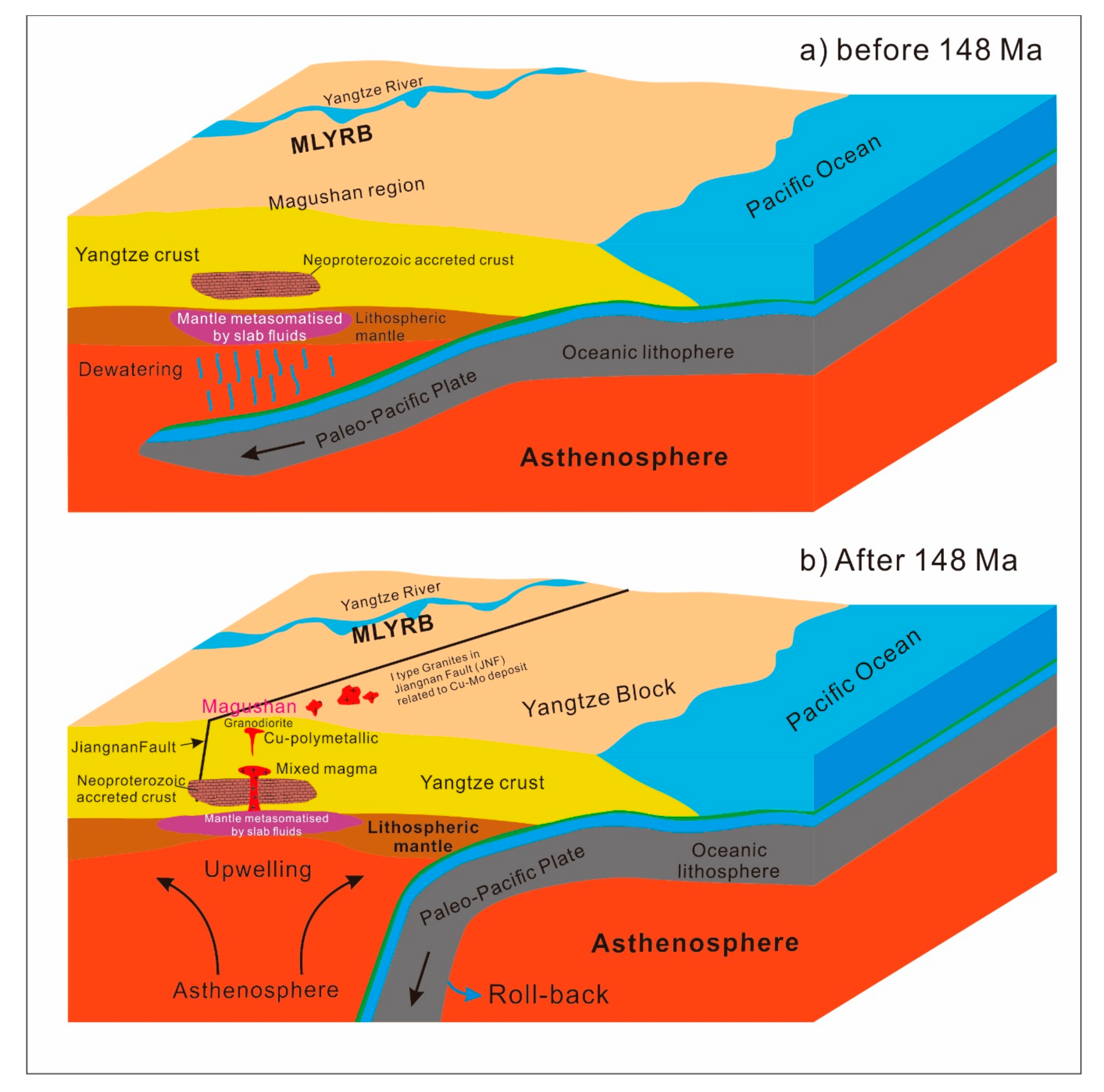
| Deposit/County/Province | Ore Type | Resource (mt, kt)/Grade | Tectonic Setting | Wall-or/Host-Rocks | Major Ore Minerals | Alteration Minerals | Intrusions Rocks | Reference |
|---|---|---|---|---|---|---|---|---|
| Magushan/Xuancheng/Anhui | Skarn Cu–Mo | Cu: 73 Kt @0.6–1.2%; Mo: 8.0Kt @ 0.06–0.12% | Northeastern part of the JNF | Permian Gufeng-Qixia Fm. Limestone | Chalcopyrite, molybdenite, pyrite | Grt, Di, Cal, Chl, Ep, Kfs | Granodiorite, | This study |
| Matou/Chizhou/Anhui | Porphyry Cu–Mo | Mo: 40 Kt @ 0.052%; Cu: >10 Kt @0.2–0.9% | Southern part of the JNF | Silurian siltstone, shale | Molybdenite, chalcopyrite, pyrite | Kfs, Ser, Chl, Ep | 146.7 Ma Granodiorite porphyry | [11] |
| Jitoushan/Chizhou/Anhui | Skarn Cu–Mo–W | W: >10 Kt @?; Mo: >10 Kt @? | Southern part of the JNF | Cambrian Yangliugang Fm. limestone | Scheelite, molybdenite, chalcopyrite | Grt, Di, Fl, Ep, Cal, Chl | 138 Ma Granodiorite | [12] |
| Pailou/Chizhou/Anhui | Mo–Au | Mo: ? @ 0.04–0.13%; Au: ? @ 1.19–22.0 g/t | Southern part of the JNF | Silurian-Devonian clastic sedimentary rocks | Pyrite, molybdenite, stibnite | Kfs, Ser, Chl, Ep | 148 Ma Granodiorite porphyry | [13] |
| Anzhishan/Chizhou/Anhui | Cu–Mo | Cu: ? @ 0.25–1.0%; Mo: ? @ 0.04–0.1% | Southern part of the JNF | Ordovician carbonate and Silurian clastic rocks | chalcopyrite, molybdenite, pyrite, pyrrhotite | Cal, Ser, Grt, Chl, Di | Granodiorite porphyry | [13] |
| Tongshankou/Daye/Hubei | P–S Cu–Mo | Cu: 0.5 Mt @ 0.9–1.0%; Mo: 2 Kt @ 0.02–0.07% | Middle-lower Yangtze river Metallogenic belt | Early Triassic Daye Gp. carbonates | Chalcopyrite, bornite, molybdenite | Kfs, Bt, Ser, Chl, Grt, Di | 140.6 Ma Granodiorite porphyries | [24] |
| Chengmenshan/Ruichang/Jiangxi | P–S Cu–Mo | Cu: 3.07 Mt @ 0.75%; Mo: >10 Kt @ 0.05% | Middle-lower Yangtze river Metallogenic belt | Silurian-Triassic clastic rocks and carbonate | Chalcopyrite, scheelite, molybdenite | Q, Cal, Grt, Kfs, Bt | Early Cretaceous Granodiorite porphyry | [2] |
| Hucunnan/Tongling/Anhui | Skarn Cu–Mo | Mo: ? @ 0.07–0.12%; Cu: 2Mt@ 0.4–0.8% | Middle-lower Yangtze river Metallogenic belt | Permian Qixia Fm. | Molybdenite, chalcopyrite, pyrite | Q, Grt, Di, Cal | 137.5 Ma Granodiorite porphyry | [25] |
© 2019 by the authors. Licensee MDPI, Basel, Switzerland. This article is an open access article distributed under the terms and conditions of the Creative Commons Attribution (CC BY) license (http://creativecommons.org/licenses/by/4.0/).
Share and Cite
Qi, H.; Lu, S.; Yang, X.; Zhou, Y.; Zhao, L.; Deng, J.; Li, J. Formation of the Granodiorite-Hosting Magushan Cu–Mo Polymetallic Deposit in Southern Anhui, Eastern China: Evidences from Geochronology and Geochemistry. Minerals 2019, 9, 475. https://doi.org/10.3390/min9080475
Qi H, Lu S, Yang X, Zhou Y, Zhao L, Deng J, Li J. Formation of the Granodiorite-Hosting Magushan Cu–Mo Polymetallic Deposit in Southern Anhui, Eastern China: Evidences from Geochronology and Geochemistry. Minerals. 2019; 9(8):475. https://doi.org/10.3390/min9080475
Chicago/Turabian StyleQi, Huasheng, Sanming Lu, Xiaoyong Yang, Yuzhang Zhou, Lili Zhao, Jianghong Deng, and Jianshe Li. 2019. "Formation of the Granodiorite-Hosting Magushan Cu–Mo Polymetallic Deposit in Southern Anhui, Eastern China: Evidences from Geochronology and Geochemistry" Minerals 9, no. 8: 475. https://doi.org/10.3390/min9080475
APA StyleQi, H., Lu, S., Yang, X., Zhou, Y., Zhao, L., Deng, J., & Li, J. (2019). Formation of the Granodiorite-Hosting Magushan Cu–Mo Polymetallic Deposit in Southern Anhui, Eastern China: Evidences from Geochronology and Geochemistry. Minerals, 9(8), 475. https://doi.org/10.3390/min9080475






